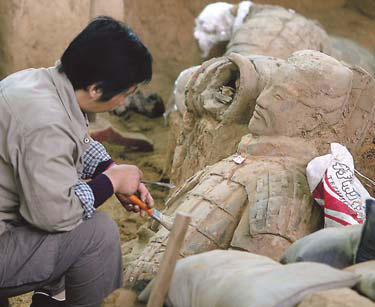Focus
Hidden wonders of underground world
(China Daily)
Updated: 2010-09-09 08:00
 |
Large Medium Small |
|
An archaeologist works carefully on a newly unearthed terracotta soldier in No 1 pit, the largest of the three surrounding the tomb of China's first emperor Qin Shihuang. Yang Shen / for China Daily |
XI'AN - The tomb of Qin Shihuang (259-210 BC), China's first emperor, was discovered completely by accident in March of 1974.
Several farmers from Xiyang village, which is in the eastern suburbs of Xi'an, capital of Shaanxi province, were digging a well when they uncovered a clay figure.
What they initially suspected to be a ghost turned out to be just a small part of the eighth wonder of the world - the terracotta army.
Archaeologists arrived on the scene and, after a drilling survey, identified three pits surrounding the tomb. An estimated 6,000 figures were buried with the emperor, including warriors, horses and chariots.
It is believed that the army was intended to protect the Qin Dynasty (221-206 BC) ruler in the afterlife.
In 1975, a museum housing the No 1 pit - covering an area of 16,300 square meters - was built with permission from the State Council. It was eventually opened to the public on Oct 1, 1979, a year into the first excavation.
The Museum of the Terracotta Warriors and Horses of Qin Shihuang was listed as a UNESCO World Heritage Site in 1987 and is one of the most popular tourist destinations in China.
So far, 114 terracotta figures have been discovered during the third dig at the No 1 pit, which began in June last year.
"We also found clay horses and a number of other relics, like bronze weapons, wooden chariots, drums and wooden rings," said Xu Weihong, acting head of the museum's excavation team.
Traces of burn marks on the warriors' bodies and the walls show the pit was at some point set on fire, while some of the newly discovered figures were between 1.8 meters and 2 meters tall.
"We're not certain whether people who lived in the Qin Dynasty were actually that tall or if the craftsmen exaggerated their height," said Xu.
As well as the warriors, archaeologists also found piles of charcoal that were believed to be grain in ancient times and three "suitcases" made of a fabric similar to silk.
"We have almost completed the excavation on the first aisle and still working hard on the second," said Xu. "As the newly unearthed figures were broken into small pieces, we have to spend more time to take them out and then put them together."
She said she could not predict when the dig will be finished but assured that "the progress of our work is based on the progress of protection".
China Daily
